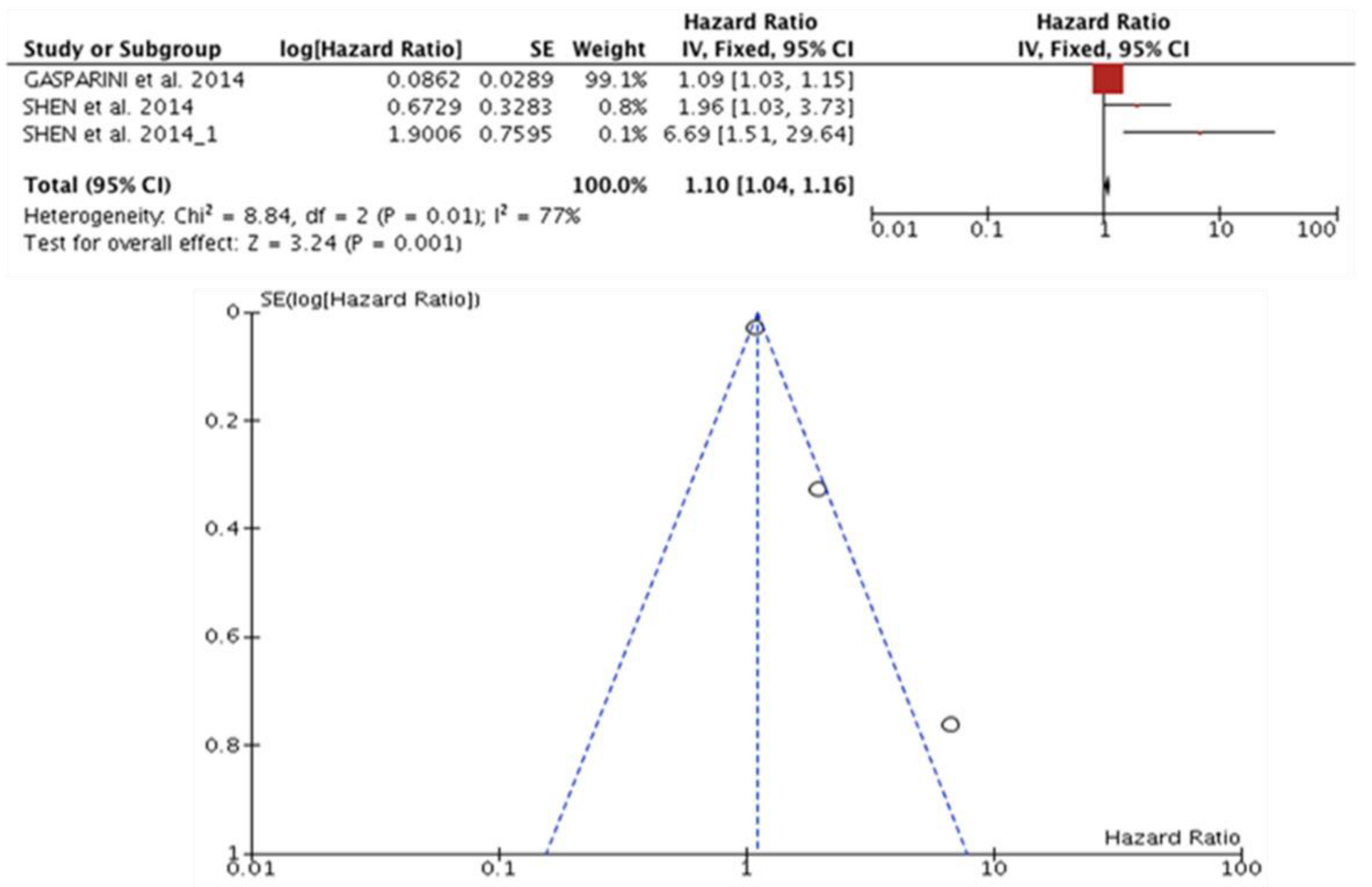The Role of miRNAs in the Prognosis of Triple-Negative Breast Cancer: A Systematic Review and Meta-Analysis
Abstract
1. Introduction
2. Materials and Methods
2.1. Protocol and Registration
2.2. Eligibility Criteria
2.3. Information Sources and Search Strategy
2.4. Study Selection and Data Collection
2.5. Risk of Bias in Individual Studies and Quality Assessment
2.6. Statistical Analysis
3. Results
3.1. Selection of the Study
3.2. Characteristics of the Included Studies
3.3. miRNA Research in the Studies
3.4. miR-155 and Prognosis in TNBC
3.5. miR-21 and Prognosis in TNBC
3.6. miR-30 and the Prognosis in TNBC
3.7. miR-374 and Prognosis in TNBC
3.8. miR-301 and Prognosis in TNBC
3.9. miR-27 and Prognosis in TNBC
4. Discussion
5. Conclusions
Supplementary Materials
Author Contributions
Funding
Institutional Review Board Statement
Informed Consent Statement
Data Availability Statement
Conflicts of Interest
References
- Gupta, I.; Sareyeldin, R.M.; Al-Hashimi, I.; Al-Thawadi, H.A.; Al Farsi, H.; Vranic, S.; Al Moustafa, A.E. Triple Negative Breast Cancer Profile, from Gene to MicroRNA, in Relation to Ethnicity. Cancers 2019, 11, 363. [Google Scholar] [CrossRef] [PubMed]
- Siegel, R.L.; Miller, K.D.; Jemal, A. Cancer Statistics, 2017. CA Cancer J. Clin. 2017, 67, 7–30. [Google Scholar] [CrossRef] [PubMed]
- Breast Cancer. Available online: https://www.who.int/news-room/fact-sheets/detail/breast-cancer (accessed on 19 June 2022).
- Weigelt, B.; Reis-Filho, J.S. Histological and Molecular Types of Breast Cancer: Is There a Unifying Taxonomy? Nat. Rev. Clin. Oncol. 2009, 6, 718–730. [Google Scholar] [CrossRef] [PubMed]
- Foulkes, W.D.; Smith, I.E.; Reis-Filho, J.S. Triple-Negative Breast Cancer. N. Engl. J. Med. 2010, 363, 1938–1948. [Google Scholar] [CrossRef] [PubMed]
- Hamam, R.; Hamam, D.; Alsaleh, K.A.; Kassem, M.; Zaher, W.; Alfayez, M.; Aldahmash, A.; Alajez, N.M. Circulating MicroRNAs in Breast Cancer: Novel Diagnostic and Prognostic Biomarkers. Cell Death Dis. 2017, 8, e3045. [Google Scholar] [CrossRef] [PubMed]
- Date, J.; Hon, C.; Singh, B.; Sahin, A.; Du, G.; Wang, J.; Wang, V.Y.; Deng, M.; Zhang, D.Y.; Monaco, M.E.; et al. Breast Cancer Molecular Subtypes: From TNBC to QNBC. Am. J. Cancer Res. 2016, 6, 1864–1872. [Google Scholar]
- Anjum, F. A review of breast cancer risk factors. Univers. J. Pharm. Res. 2017, 2, 40–45. [Google Scholar] [CrossRef]
- Barnard, M.E.; Boeke, C.E.; Tamimi, R.M. Established Breast Cancer Risk Factors and Risk of Intrinsic Tumor Subtypes. Biochim. Et Biophys. Acta-Rev. Cancer 2015, 1856, 73–85. [Google Scholar] [CrossRef]
- Sun, G.; Ma, B.; Yang, L.; Shan, M.; Dong, C.; Ma, B. MicroRNA-181a Is a Predictor of Poor Survival and a Prognostic Biomarker of Chemoresistance in Triple Negative Breast Cancer. Int. J. Clin. Exp. Pathol. 2016, 9, 8513–8519. [Google Scholar]
- Rojas, K.; Stuckey, A. Breast Cancer Epidemiology and Risk Factors. Clin. Obstet. Gynecol. 2016, 59, 651–672. [Google Scholar] [CrossRef]
- Maas, P.; Barrdahl, M.; Joshi, A.D.; Auer, P.L.; Gaudet, M.M.; Milne, R.L.; Schumacher, F.R.; Anderson, W.F.; Check, D.; Chattopadhyay, S.; et al. Breast Cancer Risk From Modifiable and Nonmodifiable Risk Factors Among White Women in the United States. JAMA Oncol. 2016, 2, 1295–1302. [Google Scholar] [CrossRef] [PubMed]
- Kamińska, M.; Ciszewski, T.; Łopacka-Szatan, K.; Miotła, P.; Starosławska, E. Breast Cancer Risk Factors. Prz. Menopauzalny 2015, 14, 196–202. [Google Scholar] [CrossRef]
- Johnsson, A.; Broberg, P.; Johnsson, A.; Tornberg, Å.B.; Olsson, H. Occupational Sedentariness and Breast Cancer Risk. Acta Oncol. 2017, 56, 75–80. [Google Scholar] [CrossRef] [PubMed]
- Lehmann, B.D.; Bauer, J.A.; Chen, X.; Sanders, M.E.; Chakravarthy, A.B.; Shyr, Y.; Pietenpol, J.A. Identification of Human Triple-Negative Breast Cancer Subtypes and Preclinical Models for Selection of Targeted Therapies. J. Clin. Investig. 2011, 121, 2750–2767. [Google Scholar] [CrossRef] [PubMed]
- Mahmood, H.; Faheem, M.; Mahmood, S.; Sadiq, M.; Irfan, J. Impact of Age, Tumor Size, Lymph Node Metastasis, Stage, Receptor Status and Menopausal Status on Overall Survival of Breast Cancer Patients in Pakistan. Asian Pac. J. Cancer Prev. 2015, 16, 1019–1024. [Google Scholar] [CrossRef] [PubMed]
- Ahmed, S.T.; Ahmed, A.M.; Musa, D.H.; Sulayvani, F.K.; Al-Khyatt, M.; Pity, I.S. Proliferative Index (Ki67) for Prediction in Breast Duct Carcinomas. Asian Pac. J. Cancer Prev. 2018, 19, 955–959. [Google Scholar] [CrossRef]
- Stovgaard, E.S.; Nielsen, D.; Hogdall, E.; Balslev, E. Triple Negative Breast Cancer–Prognostic Role of Immune-Related Factors: A Systematic Review. Acta Oncol. 2018, 57, 74–82. [Google Scholar] [CrossRef] [PubMed]
- Thakur, S.; Grover, R.K.; Gupta, S.; Yadav, A.K.; Das, B.C. Identification of Specific MiRNA Signature in Paired Sera and Tissue Samples of Indian Women with Triple Negative Breast Cancer. PLoS ONE 2016, 11, e0158946. [Google Scholar] [CrossRef] [PubMed]
- Mekala, J.R.; Naushad, S.M.; Ponnusamy, L.; Arivazhagan, G.; Sakthiprasad, V.; Pal-Bhadra, M. Epigenetic Regulation of MiR-200 as the Potential Strategy for the Therapy against Triple-Negative Breast Cancer. Gene 2018, 641, 248–258. [Google Scholar] [CrossRef] [PubMed]
- Berezikov, E.; Cuppen, E.; Plasterk, R.H.A. Approaches to Microrna Discovery. Nat. Genet. 2006, 38, S2. [Google Scholar] [CrossRef]
- Lee, R.C.; Feinbaum, R.L.; Ambros, V. The C. Elegans Heterochronic Gene Lin-4 Encodes Small RNAs with Antisense Complementarity to Lin-14. Cell 1993, 75, 843–854. [Google Scholar] [CrossRef]
- McCreight, J.C.; Schneider, S.E.; Wilburn, D.B.; Swanson, W.J. Evolution of MicroRNA in Primates. PLoS ONE 2017, 12, e0176596. [Google Scholar] [CrossRef]
- Shah, M.Y.; Ferrajoli, A.; Sood, A.K.; Lopez-Berestein, G.; Calin, G.A. MicroRNA Therapeutics in Cancer—An Emerging Concept. EBioMedicine 2016, 12, 34–42. [Google Scholar] [CrossRef] [PubMed]
- Lü, L.; Mao, X.; Shi, P.; He, B.; Xu, K.; Zhang, S.; Wang, J. MicroRNAs in the Prognosis of Triple-Negative Breast Cancer. Medicine 2017, 96, e7085. [Google Scholar] [CrossRef]
- Svoboda, M.; Sana, J.; Redova, M.; Navratil, J.; Palacova, M.; Fabian, P.; Slaby, O.; Vyzula, R. MiR-34b Is Associated with Clinical Outcome in Triple-Negative Breast Cancer Patients. Diagn. Pathol. 2012, 7, 31. [Google Scholar] [CrossRef]
- Nama, S.; Muhuri, M.; di Pascale, F.; Quah, S.; Aswad, L.; Fullwood, M.; Sampath, P. MicroRNA-138 Is a Prognostic Biomarker for Triple-Negative Breast Cancer and Promotes Tumorigenesis via TUSC2 Repression. Sci. Rep. 2019, 9, 12718. [Google Scholar] [CrossRef] [PubMed]
- Cao, Z.-G.; Li, J.-J.; Yao, L.; Huang, Y.-N.; Liu, Y.-R.; Hu, X.; Song, C.-G.; Shao, Z.-M. High Expression of MicroRNA-454 Is Associated with Poor Prognosis in Triple-Negative Breast Cancer. Oncotarget 2016, 7, 64900–64909. [Google Scholar] [CrossRef]
- Li, H.Y.; Liang, J.L.; Kuo, Y.L.; Lee, H.H.; Calkins, M.J.; Chang, H.T.; Lin, F.C.; Chen, Y.C.; Hsu, T.I.; Hsiao, M.; et al. MiR-105/93-3p Promotes Chemoresistance and Circulating MiR-105/93-3p Acts as a Diagnostic Biomarker for Triple Negative Breast Cancer. Breast Cancer Res. 2017, 19, 133. [Google Scholar] [CrossRef]
- Moher, D.; Liberati, A.; Tetzlaff, J.; Altman, D.G. Preferred Reporting Items for Systematic Reviews and Meta-Analyses: The Prisma Statement. J. Clin. Epidemiol. 2009, 62, 1006–1012. [Google Scholar] [CrossRef]
- Stroup, D.F.; Berlin, J.A.; Morton, S.C.; Olkin, I.; Williamson, G.D.; Rennie, D.; Moher, D.; Becker, B.J.; Sipe, T.A.; Thacker, S.B. Meta-Analysis of Observational Studies in Epidemiology A Proposal for Reporting B Ecause of Pressure for Timely. JAMA 2000, 283, 2008–2012. [Google Scholar] [CrossRef]
- Wells, G.; Shea, B.; Robertson, J.; Peterson, J.; Welch, V.; Losos, M.; Tugwell, P. The Newcastle-Ottawa Scale (NOS) for Assessing the Quality of Nonrandomized Studies in Meta-Analysis. 2014. Available online: https://www.ohri.ca/programs/clinical_epidemiology/oxford.asp (accessed on 17 July 2022).
- Higgins, J.P.T.; Thompson, S.G.; Deeks, J.J.; Altman, D.G. Measuring Inconsistency in Meta-Analyses. Br. Med. J. 2003, 327, 557–560. [Google Scholar] [CrossRef]
- Borenstein, M.; Hedges, L.V.; Higgins, J.P.T.; Rothstein, H.R. Introduction to Meta-Analysis; International Statistical Review; John Wiley & Sons: Hoboken, NJ, USA, 2009. [Google Scholar]
- Cao, Z.G.; Huang, Y.N.; Yao, L.; Liu, Y.R.; Hu, X.; Hou, Y.F.; Shao, Z.M. Positive Expression of MiR-361-5p Indicates Better Prognosis for Breast Cancer Patients. J. Thorac. Dis. 2016, 8, 1772–1779. [Google Scholar] [CrossRef]
- Cascione, L.; Gasparini, P.; Lovat, F.; Carasi, S.; Pulvirenti, A.; Ferro, A.; Alder, H.; He, G.; Vecchione, A.; Croce, C.M.; et al. Integrated MicroRNA and MRNA Signatures Associated with Survival in Triple Negative Breast Cancer. PLoS ONE 2013, 8, e55910. [Google Scholar] [CrossRef]
- Chen, L.L.; Zhang, Z.J.; Yi, Z.B.; Li, J.J. MicroRNA-211-5p Suppresses Tumour Cell Proliferation, Invasion, Migration and Metastasis in Triple-Negative Breast Cancer by Directly Targeting SETBP1. Br. J. Cancer 2017, 117, 78–88. [Google Scholar] [CrossRef] [PubMed]
- Deng, L.; Lei, Q.; Wang, Y.; Wang, Z.; Xie, G.; Zhong, X.; Wang, Y.; Chen, N.; Qiu, Y.; Pu, T.; et al. Downregulation of MiR-221-3p and Upregulation of Its Target Gene PARP1 Are Prognostic Biomarkers for Triple Negative Breast Cancer Patients and Associated with Poor Prognosis. Oncotarget 2017, 8, 108712–108725. [Google Scholar] [CrossRef] [PubMed]
- de Rinaldis, E.; Gazinska, P.; Mera, A.; Modrusan, Z.; Fedorowicz, G.M.; Burford, B.; Gillett, C.; Marra, P.; Grigoriadis, A.; Dornan, D.; et al. Integrated Genomic Analysis of Triple-Negative Breast Cancers Reveals Novel MicroRNAs Associated with Clinical and Molecular Phenotypes and Sheds Light on the Pathways They Control. BMC Genom. 2013, 14, 634. [Google Scholar] [CrossRef]
- Dong, G.; Liang, X.; Wang, D.; Gao, H.; Wang, L.; Wang, L.; Liu, J.; Du, Z. High Expression of MiR-21 in Triple-Negative Breast Cancers Was Correlated with a Poor Prognosis and Promoted Tumor Cell in Vitro Proliferation. Med. Oncol. 2014, 31, 57. [Google Scholar] [CrossRef]
- Gasparini, P.; Cascione, L.; Fassan, M.; Lovat, F.; Guler, G.; Balci, S.; Irkkan, C.; Morrison, C.; Croce, C.M.; Shapiro, C.L.; et al. MicroRNA Expression Profiling Identifies a Four MicroRNA Signature as a Novel Diagnostic and Prognostic Biomarker in Triple Negative Breast Cancers. Oncotarget 2014, 5, 1174–1184. [Google Scholar] [CrossRef] [PubMed]
- Gong, W.; Zhu, C.; Liu, Y.; Muckenhuber, A.; Bronger, H.; Scorilas, A.; Kiechle, M.; Dorn, J.; Magdolen, V.; Dreyer, T. Elevated Levels of Both MicroRNA 378 (MiR-378) and Kallikrein-Related Peptidase 4 (KLK4) MRNA are Associated with an Unfavorable Prognosis in Triple-Negative Breast Cancer. Am. J. Transl. Res. 2021, 13, 1594–1606. [Google Scholar]
- Jang, M.H.; Kim, H.J.; Gwak, J.M.; Chung, Y.R.; Park, S.Y. Prognostic Value of MicroRNA-9 and MicroRNA-155 Expression in Triple-Negative Breast Cancer. Hum. Pathol. 2017, 68, 69–78. [Google Scholar] [CrossRef]
- Kalniete, D.; Nakazawa-Miklaševiča, M.; Štrumfa, I.; Abolinš, A.; Irmejs, A.; Gardovskis, J.; Miklaševičs, E. High Expression of MiR-214 Is Associated with a Worse Disease-Specific Survival of the Triple-Negative Breast Cancer Patients. Hered. Cancer Clin. Pract. 2015, 13, 7. [Google Scholar] [CrossRef] [PubMed][Green Version]
- Kim, D.; Lee, J.; Kang, J.; Kim, S.H.; Yoo, T.K.; Oh, S.; Lee, A. Notch1 in Tumor Microvascular Endothelial Cells and Tumoral MiR-34a as Prognostic Markers in Locally Advanced Triple-Negative Breast Cancer. J. Breast Cancer 2019, 22, 562–578. [Google Scholar] [CrossRef] [PubMed]
- Kong, W.; He, L.; Richards, E.J.; Challa, S.; Xu, C.X.; Permuth-Wey, J.; Lancaster, J.M.; Coppola, D.; Sellers, T.A.; Djeu, J.Y.; et al. Upregulation of MiRNA-155 Promotes Tumour Angiogenesis by Targeting VHL and Is Associated with Poor Prognosis and Triple-Negative Breast Cancer. Oncogene 2014, 33, 679–689. [Google Scholar] [CrossRef]
- Li, J.; Lai, Y.; Ma, J.; Liu, Y.; Bi, J.; Zhang, L.; Chen, L.; Yao, C.; Lv, W.; Chang, G.; et al. MiR-17-5p Suppresses Cell Proliferation and Invasion by Targeting ETV1 in Triple-Negative Breast Cancer. BMC Cancer 2017, 17, 745. [Google Scholar] [CrossRef] [PubMed]
- Liu, J.; Zhou, Y.; Shi, Z.; Hu, Y.; Meng, T.; Zhang, X.; Zhang, S.; Zhang, J. MicroRNA-497 Modulates Breast Cancer Cell Proliferation, Invasion, and Survival by Targeting SMAD7. DNA Cell Biol. 2016, 35, 521–529. [Google Scholar] [CrossRef] [PubMed]
- Liu, P.; Tang, H.; Chen, B.; He, Z.; Deng, M.; Wu, M.; Liu, X.; Yang, L.; Ye, F.; Xie, X. MiR-26a Suppresses Tumour Proliferation and Metastasis by Targeting Metadherin in Triple Negative Breast Cancer. Cancer Lett. 2015, 357, 384–392. [Google Scholar] [CrossRef]
- Liu, Y.; Cai, Q.; Bao, P.P.; Su, Y.; Cai, H.; Wu, J.; Ye, F.; Guo, X.; Zheng, W.; Zheng, Y.; et al. Tumor Tissue MicroRNA Expression in Association with Triple-Negative Breast Cancer Outcomes. Breast Cancer Res. Treat. 2015, 152, 183–191. [Google Scholar] [CrossRef] [PubMed]
- Lv, Z.D.; Yang, D.X.; Liu, X.P.; Jin, L.Y.; Wang, X.G.; Yang, Z.C.; Liu, D.; Zhao, J.J.; Kong, B.; Li, F.N.; et al. MiR-212-5p Suppresses the Epithelial-Mesenchymal Transition in Triple-Negative Breast Cancer by Targeting Prrx2. Cell. Physiol. Biochem. 2018, 44, 1785–1795. [Google Scholar] [CrossRef]
- Mackenzie, T.A.; Schwartz, G.N.; Calderone, H.M.; Graveel, C.R.; Winn, M.E.; Hostetter, G.; Wells, W.A.; Sempere, L.F. Stromal Expression of MiR-21 Identifies High-Risk Group in Triple-Negative Breast Cancer. Am. J. Pathol. 2014, 184, 3217–3225. [Google Scholar] [CrossRef]
- Radojicic, J.; Zaravinos, A.; Vrekoussis, T.; Kafousi, M.; Spandidos, D.A.; Stathopoulos, E.N. MicroRNA Expression Analysis in Triple-Negative (ER, PR and Her2/Neu) Breast Cancer. Cell Cycle 2011, 10, 507–517. [Google Scholar] [CrossRef]
- Romero-Cordoba, S.L.; Rodriguez-Cuevas, S.; Bautista-Pina, V.; Maffuz-Aziz, A.; D’Ippolito, E.; Cosentino, G.; Baroni, S.; Iorio, M.V.; Hidalgo-Miranda, A. Loss of Function of MiR-342-3p Results in MCT1 over-Expression and Contributes to Oncogenic Metabolic Reprogramming in Triple Negative Breast Cancer. Sci. Rep. 2018, 8, 12252. [Google Scholar] [CrossRef]
- Sahlberg, K.K.; Bottai, G.; Naume, B.; Burwinkel, B.; Calin, G.A.; Børresen-Dale, A.L.; Santarpia, L. A Serum MicroRNA Signature Predicts Tumor Relapse and Survival in Triple-Negative Breast Cancer Patients. Clin. Cancer Res. 2015, 21, 1207–1214. [Google Scholar] [CrossRef] [PubMed]
- Shen, S.; Sun, Q.; Liang, Z.; Cui, X.; Ren, X.; Chen, H.; Zhang, X.; Zhou, Y. A Prognostic Model of Triple-Negative Breast Cancer Based on MiR-27b-3p and Node Status. PLoS ONE 2014, 9, e100664. [Google Scholar] [CrossRef] [PubMed]
- Shi, D.; Li, Y.; Fan, L.; Zhao, Q.; Tan, B.; Cui, G. Upregulation of Mir-153 Inhibits Triple-Negative Breast Cancer Progression by Targeting Zeb2-Mediated Emt and Contributes to Better Prognosis. OncoTargets Ther. 2019, 12, 9611–9625. [Google Scholar] [CrossRef] [PubMed]
- Schwarzenbacher, D.; Klec, C.; Pasculli, B.; Cerk, S.; Rinner, B.; Karbiener, M.; Ivan, C.; Barbano, R.; Ling, H.; Wulf-Goldenberg, A.; et al. MiR-1287-5p Inhibits Triple Negative Breast Cancer Growth by Interaction with Phosphoinositide 3-Kinase CB, Thereby Sensitizing Cells for PI3Kinase Inhibitors. Breast Cancer Res. 2019, 21, 20. [Google Scholar] [CrossRef]
- Tang, H.; Liu, P.; Yang, L.; Xie, X.; Ye, F.; Wu, M.; Liu, X.; Chen, B.; Zhang, L.; Xie, X. MiR-185 Suppresses Tumor Proliferation by Directly Targeting E2F6 and DNMT1 and Indirectly Upregulating BRCA1 in Triple-Negative Breast Cancer. Mol. Cancer Ther. 2014, 13, 3185–3197. [Google Scholar] [CrossRef]
- Toyama, T.; Kondo, N.; Endo, Y.; Sugiura, H.; Yoshimoto, N.; Iwasa, M.; Takahashi, S.; Fujii, Y.; Yamashita, H. High Expression of MicroRNA-210 Is an Independent Factor Indicating a Poor Prognosis in Japanese Triple-Negative Breast Cancer Patients. Jpn. J. Clin. Oncol. 2012, 42, 256–263. [Google Scholar] [CrossRef]
- Turashvili, G.; Lightbody, E.D.; Tyryshkin, K.; SenGupta, S.K.; Elliott, B.E.; Madarnas, Y.; Ghaffari, A.; Day, A.; Nicol, C.J.B. Novel Prognostic and Predictive MicroRNA Targets for Triple-Negative Breast Cancer. FASEB J. 2018, 32, 5937–5954. [Google Scholar] [CrossRef]
- Uva, P.; Cossu-Rocca, P.; Loi, F.; Pira, G.; Murgia, L.; Orrù, S.; Floris, M.; Muroni, M.R.; Sanges, F.; Carru, C.; et al. MiRNA-135b Contributes to Triple Negative Breast Cancer Molecular Heterogeneity: Different Expression Profile in Basal-like versus Non-Basal-like Phenotypes. Int. J. Med. Sci. 2018, 15, 536–548. [Google Scholar] [CrossRef]
- Wang, J.; Song, C.; Tang, H.; Zhang, C.; Tang, J.; Li, X.; Chen, B.; Xie, X. MiR-629-3p May Serve as a Novel Biomarker and Potential Therapeutic Target for Lung Metastases of Triple-Negative Breast Cancer. Breast Cancer Res. 2017, 19, 72. [Google Scholar] [CrossRef]
- Wang, L.; Kang, F.B.; Wang, J.; Yang, C.; Hee, D.W. Downregulation of MiR-205 Contributes to Epithelial-Mesenchymal Transition and Invasion in Triple-Negative Breast Cancer by Targeting HMGB1-RAGE Signaling Pathway. Anti-Cancer Drugs 2019, 30, 225–232. [Google Scholar] [CrossRef] [PubMed]
- Wang, Q.; Wang, C.; Guo, J.; Fan, J.; Zhang, Z. Original Article Expression of MiR-146a in Triple Negative Breast Cancer and Its Clinical Significance. Int. J. Clin. Exp. Pathol. 2016, 9, 11832–11837. [Google Scholar]
- Wong, C.K.; Gromisch, C.; Ozturk, S.; Papageorgis, P.; Abdolmaleky, H.M.; Reinhard, B.M.; Thiagalingam, A.; Thiagalingam, S. MicroRNA-4417 Is a Tumor Suppressor and Prognostic Biomarker for Triple-Negative Breast Cancer. Cancer Biol. Ther. 2019, 20, 1113–1120. [Google Scholar] [CrossRef] [PubMed]
- Zheng, J.Z.; Huang, Y.N.; Yao, L.; Liu, Y.R.; Liu, S.; Hu, X.; Liu, Z.B.; Shao, Z.M. Elevated MiR-301a Expression Indicates a Poor Prognosis for Breast Cancer Patients. Sci. Rep. 2018, 8, 2225. [Google Scholar] [CrossRef] [PubMed]
- Yu, B.; You, W.; Chen, G.; Yu, Y.; Yang, Q. MiR-140-5p Inhibits Cell Proliferation and Metastasis by Regulating MUC1 via BCL2A1/MAPK Pathway in Triple Negative Breast Cancer. Cell Cycle 2019, 18, 2641–2650. [Google Scholar] [CrossRef]
- Yao, L.; Liu, Y.; Cao, Z.; Li, J.; Huang, Y.; Hu, X.; Shao, Z. MicroRNA-493 Is a Prognostic Factor in Triple-Negative Breast Cancer. Cancer Sci. 2018, 109, 2294–2301. [Google Scholar] [CrossRef]
- Xiao, M.; Lou, C.; Xiao, H.; Yang, Y.; Cai, X.; Li, C.; Jia, S.; Huang, Y. MiR-128 Regulation of Glucose Metabolism and Cell Proliferation in Triple-Negative Breast Cancer. Br. J. Surg. 2018, 105, 75–85. [Google Scholar] [CrossRef] [PubMed]
- Zavala, V.; Pérez-Moreno, E.; Tapia, T.; Camus, M.; Carvallo, P. MiR-146a and MiR-638 in BRCA1-Deficient Triple Negative Breast Cancer Tumors, as Potential Biomarkers for Improved Overall Survival. Cancer Biomark. 2016, 16, 99–107. [Google Scholar] [CrossRef]
- Zeng, Z.; Chen, X.; Zhu, D.; Luo, Z.; Yang, M. Low Expression of Circulating MicroRNA-34c Is Associated with Poor Prognosis in Triple-Negative Breast Cancer. Yonsei Med. J. 2017, 58, 697–702. [Google Scholar] [CrossRef]
- Yu, H.; Li, H.; Qian, H.; Jiao, X.; Zhu, X.; Jiang, X.; Dai, G.; Huang, J. Upregulation of MiR-301a Correlates with Poor Prognosis in Triple-Negative Breast Cancer. Med. Oncol. 2014, 31, 283. [Google Scholar] [CrossRef]
- Chen, L.; Zhu, X.; Han, B.; Ji, L.; Yao, L.; Wang, Z. High Expression of MicroRNA-223 Indicates a Good Prognosis in Triple-Negative Breast Cancer. Front. Oncol. 2021, 11, 630432. [Google Scholar] [CrossRef]
- Kumar, R.; Sharma, A.; Tiwari, R.K. Application of Microarray in Breast Cancer: An Overview. J. Pharm. Bioallied Sci. 2012, 4, 21–26. [Google Scholar] [CrossRef] [PubMed]
- Nassar, F.J.; Chamandi, G.; Tfaily, M.A.; Zgheib, N.K.; Nasr, E. Peripheral Blood-Based Biopsy for Breast Cancer Risk Prediction and Early Detection. Front. Med. 2020, 7, 28. [Google Scholar] [CrossRef]
- Wu, H.-J.; Chu, P.-Y. Current and Developing Liquid Biopsy Techniques for Breast Cancer. Cancers 2022, 14, 2052. [Google Scholar] [CrossRef] [PubMed]
- Boyle, P. Triple-Negative Breast Cancer: Epidemiological Considerations and Recommendations. Ann. Oncol. 2012, 23, vi7–vi12. [Google Scholar] [CrossRef]
- Shin, V.Y.; Siu, J.M.; Cheuk, I.; Ng, E.K.O.; Kwong, A. Circulating Cell-Free MiRNAs as Biomarker for Triple-Negative Breast Cancer. Br. J. Cancer 2015, 112, 1751–1759. [Google Scholar] [CrossRef] [PubMed]
- Liu, C.; Zhang, S.; Wang, Q.; Zhang, X. Tumor Suppressor MiR-1 Inhibits Tumor Growth and Metastasis by Simultaneously Targeting Multiple Genes. Oncotarget 2017, 8, 42043–42060. [Google Scholar] [CrossRef]
- Grimaldi, A.M.; Nuzzo, S.; Condorelli, G.; Salvatore, M.; Incoronato, M. Prognostic and Clinicopathological Significance of Mir-155 in Breast Cancer: A Systematic Review. Int. J. Mol. Sci. 2020, 21, 5834. [Google Scholar] [CrossRef] [PubMed]
- Zhu, S.; Wu, H.; Wu, F.; Nie, D.; Sheng, S.; Mo, Y.Y. MicroRNA-21 Targets Tumor Suppressor Genes in Invasion and Metastasis. Cell Res. 2008, 18, 350–359. [Google Scholar] [CrossRef]
- Yan, L.X.; Huang, X.F.; Shao, Q.; Huang, M.Y.; Deng, L.; Wu, Q.L.; Zeng, Y.X.; Shao, J.Y. MicroRNA MiR-21 Overexpression in Human Breast Cancer Is Associated with Advanced Clinical Stage, Lymph Node Metastasis and Patient Poor Prognosis. RNA 2008, 14, 2348–2360. [Google Scholar] [CrossRef]
- Ren, Y.Q.; Fu, F.; Han, J. MiR-27a Modulates Radiosensitivity of Triple- Negative Breast Cancer (TNBC) Cells by Targeting CDC27. Med. Sci. Monit. 2015, 21, 1297–1303. [Google Scholar] [CrossRef]
- Son, D.; Kim, Y.; Lim, S.; Kang, H.G.; Kim, D.H.; Park, J.W.; Cheong, W.; Kong, H.K.; Han, W.; Park, W.Y.; et al. MiR-374a-5p Promotes Tumor Progression by Targeting ARRB1 in Triple Negative Breast Cancer. Cancer Lett. 2019, 454, 224–233. [Google Scholar] [CrossRef] [PubMed]
- Wang, X.; Qiu, H.; Tang, R.; Song, H.; Pan, H.; Feng, Z.; Chen, L. MiR-30a Inhibits Epithelial-Mesenchymal Transition and Metastasis in Triple-Negative Breast Cancer by Targeting ROR1. Oncol. Rep. 2018, 39, 2635–2643. [Google Scholar] [CrossRef] [PubMed]
- Yin, J.; Chen, D.; Luo, K.; Lu, M.; Gu, Y.; Zeng, S.; Chen, X.; Song, Y.; Zhang, Z.; Zheng, G.; et al. Cip2a/MIR-301a Feedback Loop Promotes Cell Proliferation and Invasion of Triple-Negative Breast Cancer. J. Cancer 2019, 10, 5964–5974. [Google Scholar] [CrossRef]
- Bar, I.; Merhi, A.; Abdel-Sater, F.; ben Addi, A.; Sollennita, S.; Canon, J.L.; Delrée, P. The MicroRNA MiR-210 Is Expressed by Cancer Cells but Also by the Tumor Microenvironment in Triple-Negative Breast Cancer. J. Histochem. Cytochem. 2017, 65, 335–346. [Google Scholar] [CrossRef]
- Wu, X. Expressions of MiR-21 and MiR-210 in Breast Cancer and Their Predictive Values for Prognosis. Iran. J. Public Health 2020, 49, 21–29. [Google Scholar] [CrossRef] [PubMed]
- Li, Q.; Liu, J.; Meng, X.; Pang, R.; Li, J. MicroRNA-454 May Function as an Oncogene via Targeting AKT in Triple Negative Breast Cancer. J. Biol. Res. 2017, 24, 10. [Google Scholar] [CrossRef] [PubMed]
- Li, X.; Hou, L.; Yin, L.; Zhao, S. LncRNA XIST Interacts with MiR-454 to Inhibit Cells Proliferation, Epithelial Mesenchymal Transition and Induces Apoptosis in Triple-Negative Breast Cancer. J. Biosci. 2020, 45, 45. [Google Scholar] [CrossRef] [PubMed]
- Usmani, A.; Shoro, A.A.; Shirazi, B.; Memon, Z.; Hussain, M. MiR-16: A Novel Hereditary Marker in Breast Cancer and Their Offspring. J. Pak. Med. Assoc. 2017, 7, 446–450. [Google Scholar]
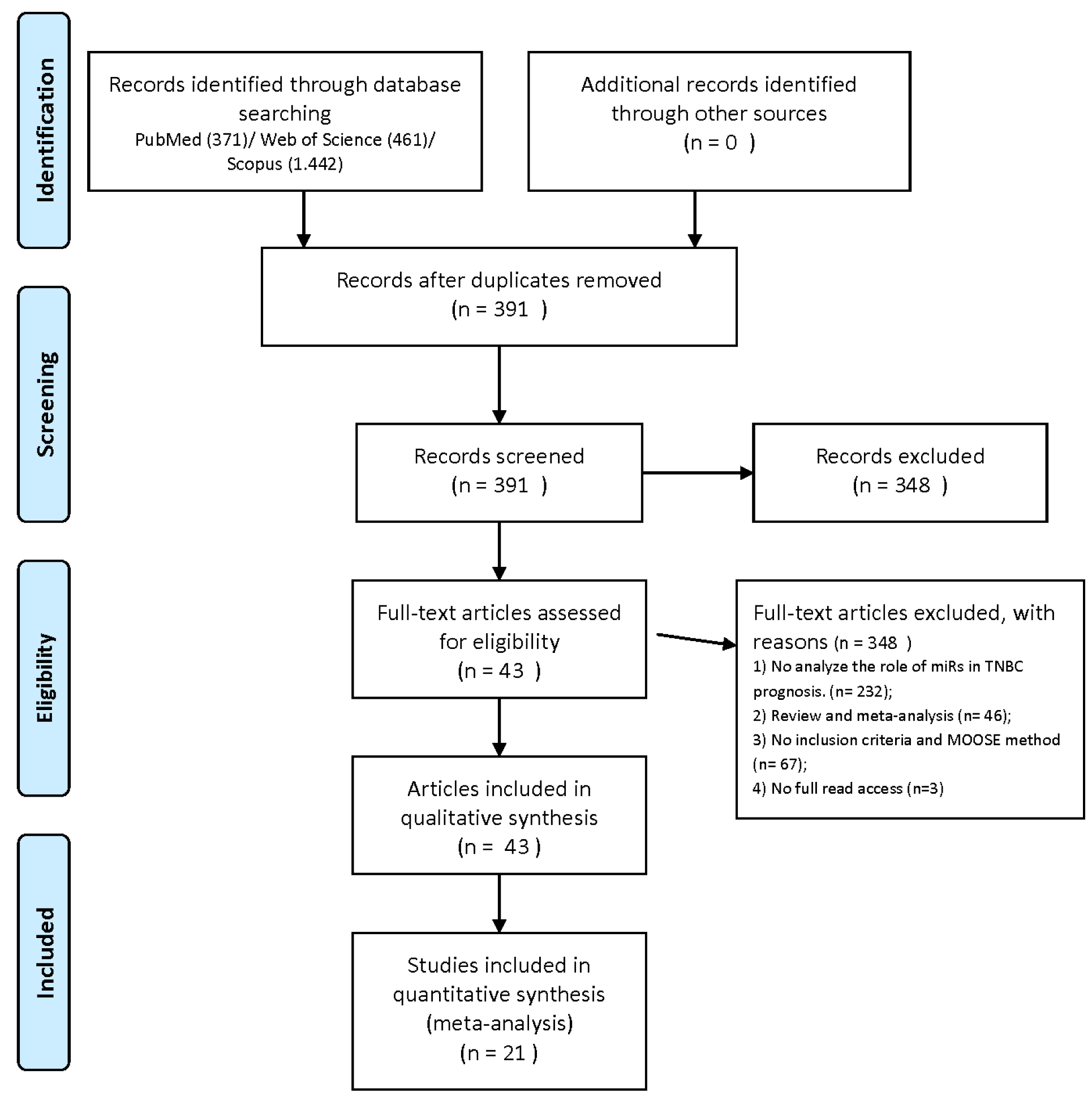
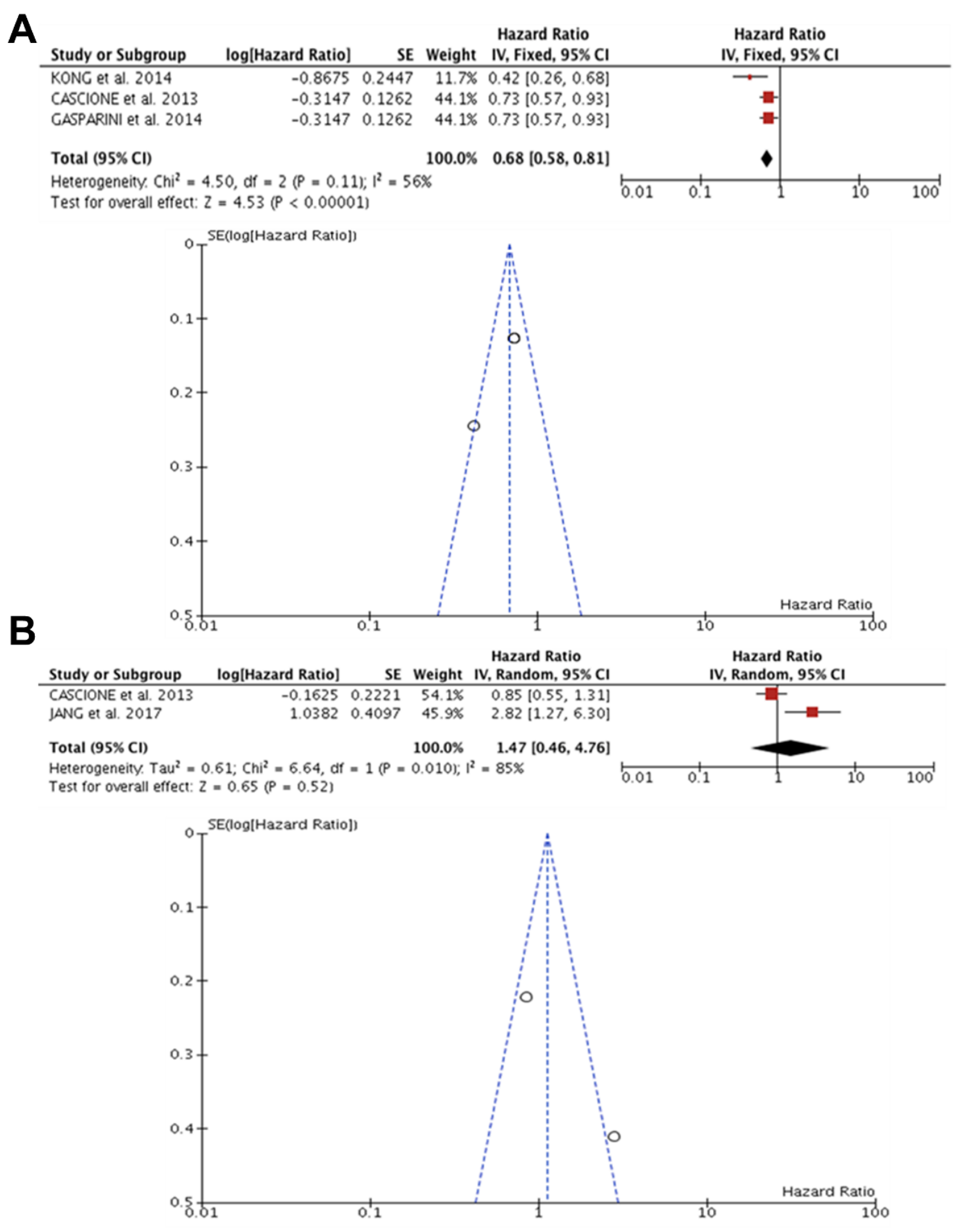
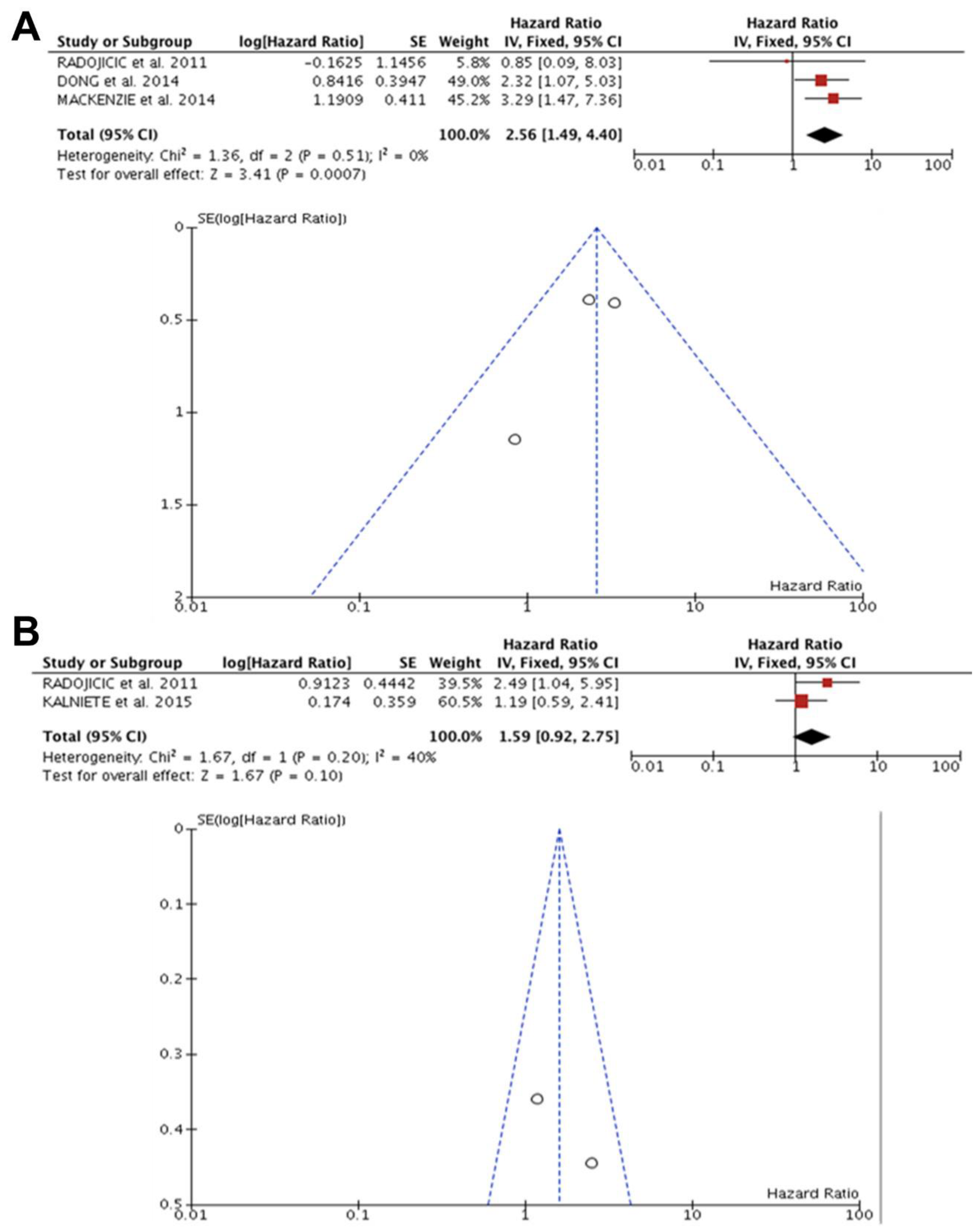

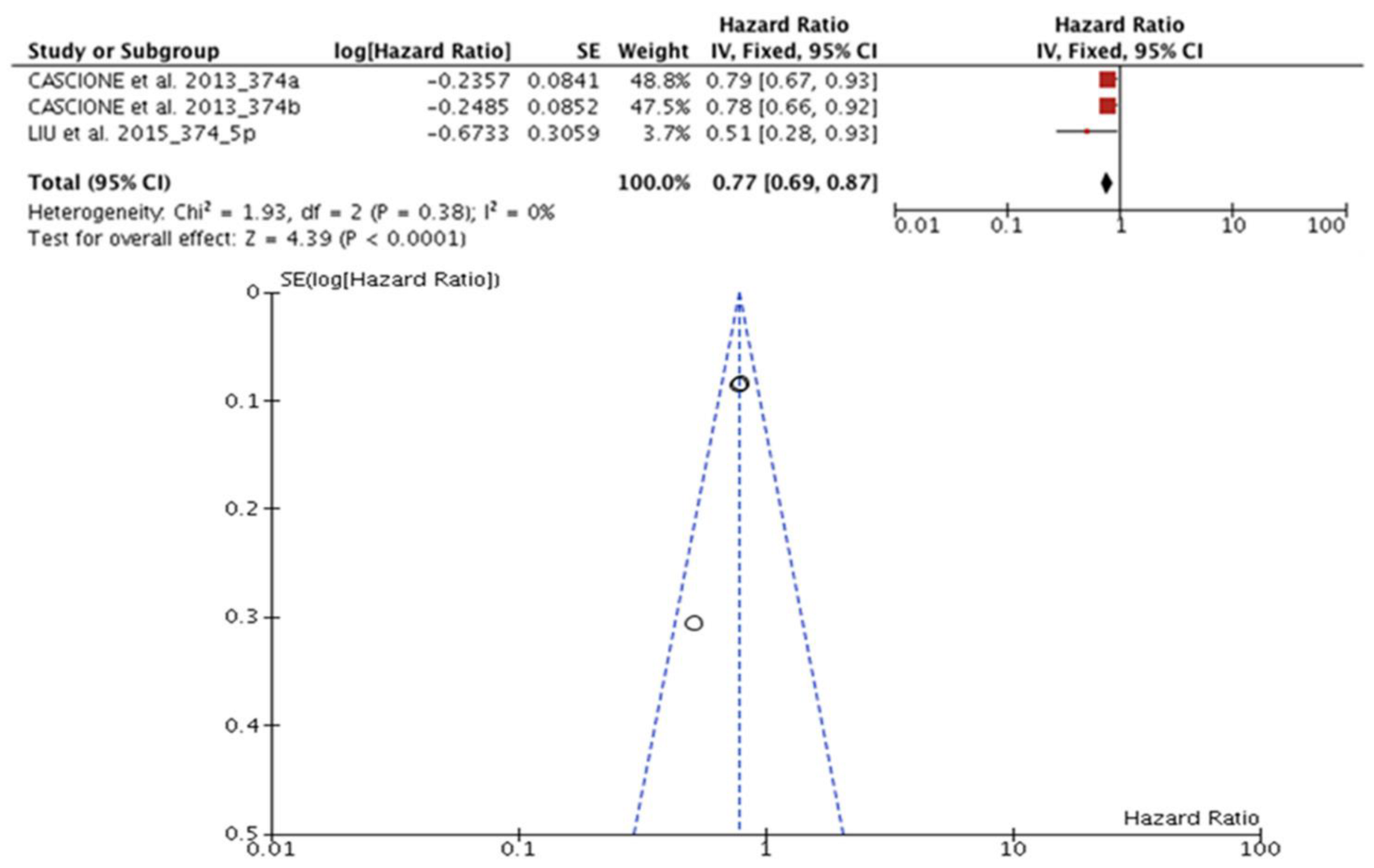
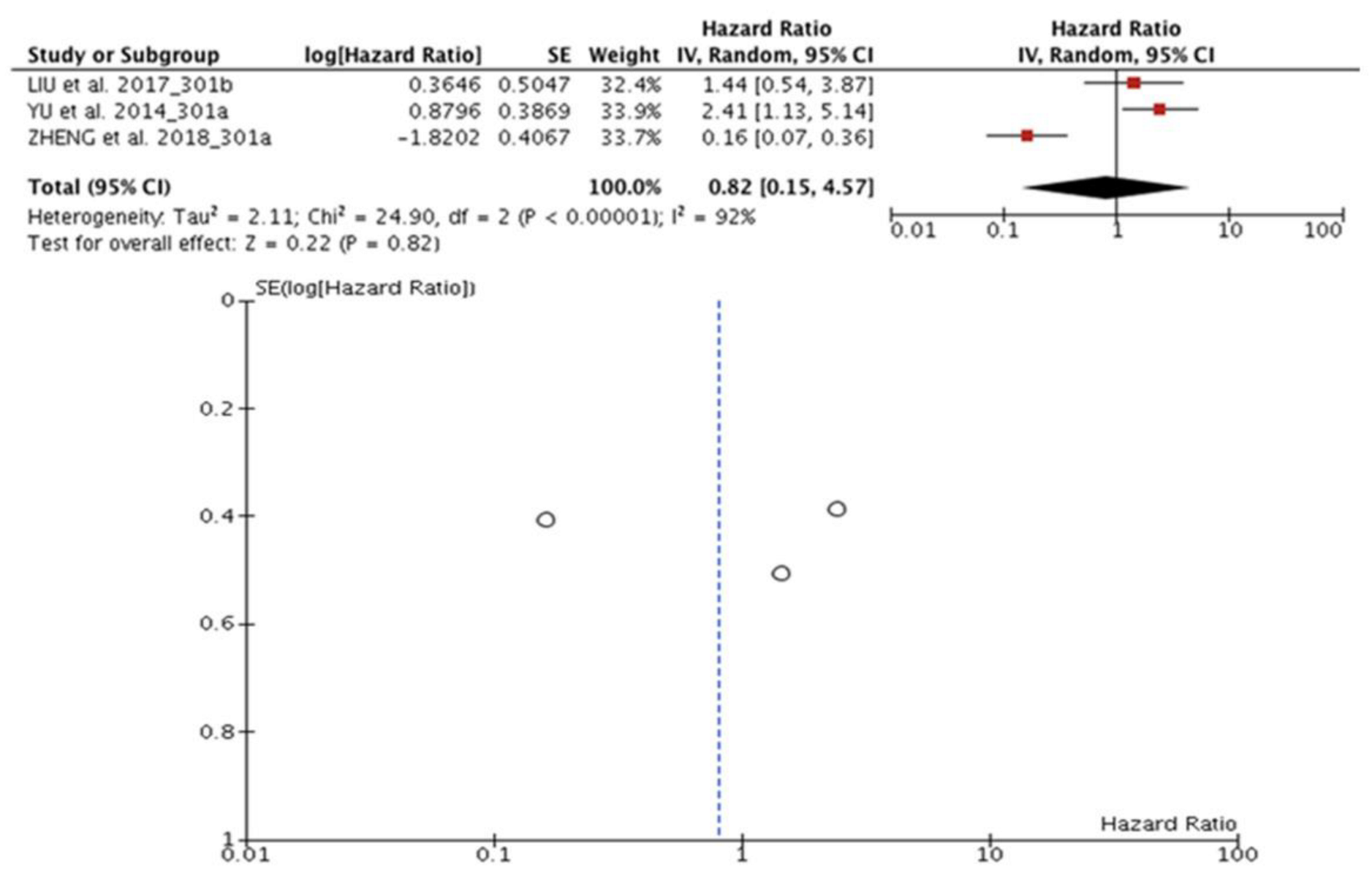
Disclaimer/Publisher’s Note: The statements, opinions and data contained in all publications are solely those of the individual author(s) and contributor(s) and not of MDPI and/or the editor(s). MDPI and/or the editor(s) disclaim responsibility for any injury to people or property resulting from any ideas, methods, instructions or products referred to in the content. |
© 2022 by the authors. Licensee MDPI, Basel, Switzerland. This article is an open access article distributed under the terms and conditions of the Creative Commons Attribution (CC BY) license (https://creativecommons.org/licenses/by/4.0/).
Share and Cite
Santana, T.A.B.d.S.; de Oliveira Passamai, L.; de Miranda, F.S.; Borin, T.F.; Borges, G.F.; Luiz, W.B.; Campos, L.C.G. The Role of miRNAs in the Prognosis of Triple-Negative Breast Cancer: A Systematic Review and Meta-Analysis. Diagnostics 2023, 13, 127. https://doi.org/10.3390/diagnostics13010127
Santana TABdS, de Oliveira Passamai L, de Miranda FS, Borin TF, Borges GF, Luiz WB, Campos LCG. The Role of miRNAs in the Prognosis of Triple-Negative Breast Cancer: A Systematic Review and Meta-Analysis. Diagnostics. 2023; 13(1):127. https://doi.org/10.3390/diagnostics13010127
Chicago/Turabian StyleSantana, Talita Araújo B. da S., Larissa de Oliveira Passamai, Felipe Silva de Miranda, Thaiz Ferraz Borin, Grasiely Faccin Borges, Wilson Barros Luiz, and Luciene Cristina Gastalho Campos. 2023. "The Role of miRNAs in the Prognosis of Triple-Negative Breast Cancer: A Systematic Review and Meta-Analysis" Diagnostics 13, no. 1: 127. https://doi.org/10.3390/diagnostics13010127
APA StyleSantana, T. A. B. d. S., de Oliveira Passamai, L., de Miranda, F. S., Borin, T. F., Borges, G. F., Luiz, W. B., & Campos, L. C. G. (2023). The Role of miRNAs in the Prognosis of Triple-Negative Breast Cancer: A Systematic Review and Meta-Analysis. Diagnostics, 13(1), 127. https://doi.org/10.3390/diagnostics13010127





